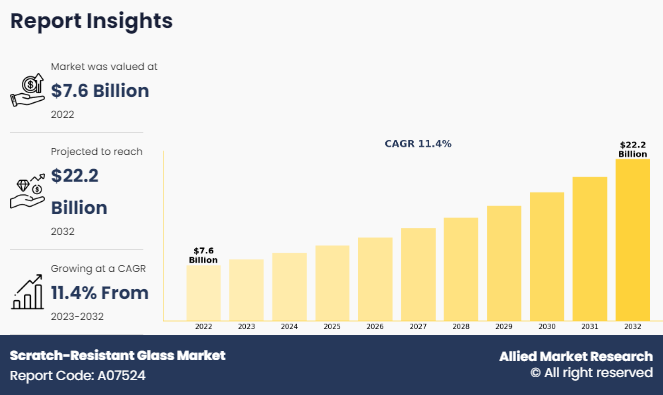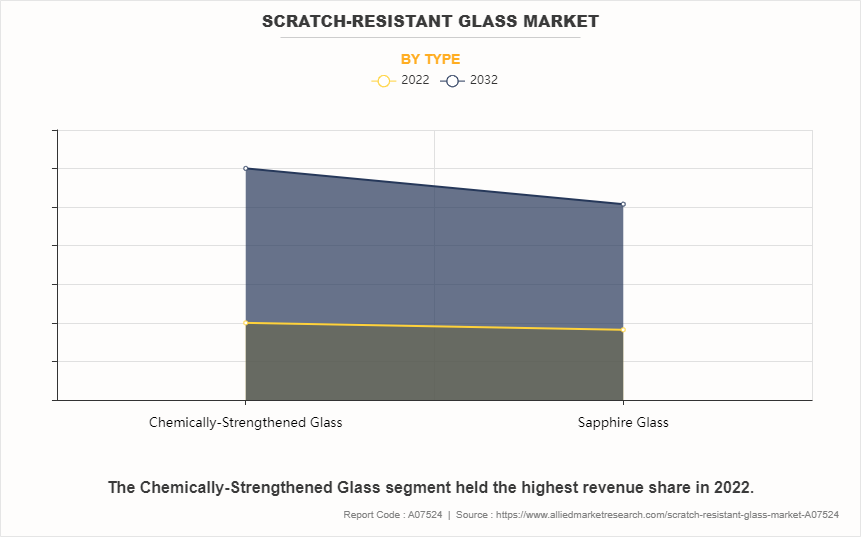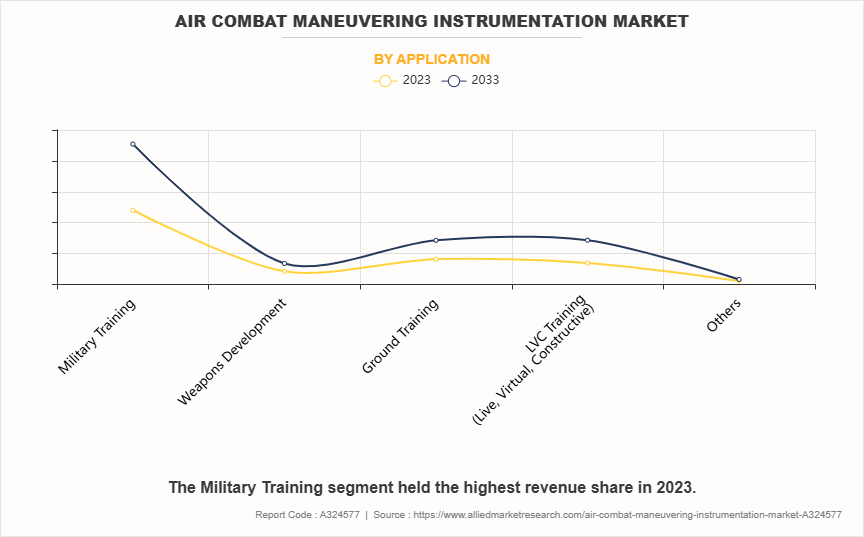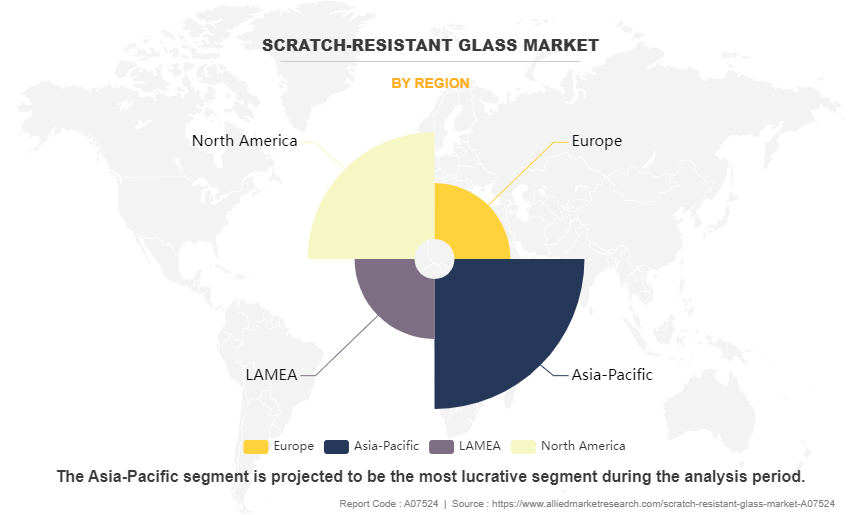Scratch-Resistant Glass Market Research, 2032
The global scratch-resistant glass market was valued at $7.6 billion in 2022, and is projected to reach $22.2 billion by 2032, growing at a CAGR of 11.4% from 2023 to 2032.
Scratch resistance is the property of a glass that is resistant to repeated rubbing or scratching. Scratch testing is carried out to get an insight into materials to determine the resistance to abrasion and wear of modern composite materials and automotive paints varnishes, as well as coatings. Scratch testing is a simple and rapid method of characterizing coatings, but results obtained are influenced by various factors such as coating thickness, substrate mechanical properties, interfacial bond strength, and test conditions such as scratch speed, load, and indenter tip radius.

The increasing rate of urbanization globally has led to a surge in construction activities, including residential, commercial, and industrial projects. Infrastructure development projects such as airports, railway stations, and public buildings also contribute to the demand for scratch-resistant glass for various applications like windows, doors, and facades. Scratch-resistant glass market size offers enhanced aesthetics and design flexibility, making it a preferred choice for architects and designers. Its ability to maintain clarity and transparency over time while resisting scratches and abrasions adds value to modern architectural designs.
Scratch-resistant glass industry provides durability and longevity, reducing maintenance costs over the lifespan of buildings. It can withstand harsh environmental conditions, including exposure to weather elements, ensuring longevity and reliability in architectural applications. Some Scratch-resistant glass industry products are designed to improve energy efficiency by reducing heat transfer and enhancing insulation properties. This makes them suitable for use in green buildings and energy-efficient construction projects, further driving their adoption in the construction and architectural industries. Increasing focus on building codes and regulations related to safety, energy efficiency, and sustainability is driving the adoption of scratch-resistant glass in construction projects. Compliance with regulatory standards and certifications such as LEED (Leadership in Energy and Environmental Design) further incentivizes the use of scratch-resistant glass in sustainable building projects.
Developing scratch-resistant glass typically involves incorporating specialized materials or coatings, such as sapphire, diamond-like carbon (DLC), or other advanced nanomaterials. These materials often come at a higher cost compared to traditional glass components. Implementing scratch-resistant properties into glass requires intricate manufacturing processes, such as chemical vapor deposition (CVD), physical vapor deposition (PVD), or ion beam sputtering. These processes necessitate sophisticated equipment and skilled labor, adding to production costs.
Ensuring the Scratch-resistant glass market growth involves rigorous quality control measures and testing procedures to meet industry standards and customer expectations. These additional steps contribute to the overall cost of production. Due to the specialized nature of scratch-resistant glass production, achieving economies of scale can be challenging. Smaller production volumes often result in higher unit costs, making it difficult to compete with traditional glass products in terms of pricing. Compliance with environmental regulations and safety standards contributes to a further increase in cost to production. Meeting these requirements often involves investing in eco-friendly manufacturing processes and materials, which can further increase production expenses.
Advancements in materials science and manufacturing techniques are enabling the development of new types of scratch-resistant glass with enhanced properties such as flexibility, transparency, and resistance to impact and abrasion. These innovations open opportunities for applications in emerging technologies such as flexible displays, augmented reality devices, and smart surfaces. Augmented reality (AR) devices, such as smart glasses and headsets, rely on transparent screens to overlay digital information onto the real world. Scratch-resistant glass with high transparency ensures a clear and unobstructed view, enhancing the user experience and minimizing distractions caused by scratches or blemishes on the display.
The integration of touchscreens into various surfaces, such as countertops, tabletops, and automotive interiors, is becoming increasingly popular. Scratch-resistant glass can serve as a protective layer for these touch-sensitive surfaces, ensuring longevity and maintaining aesthetic appeal despite frequent use and potential abrasions. In the automotive industry, scratch-resistant glass can find applications in vehicle displays, infotainment systems, and heads-up displays (HUDs). Enhanced durability and resistance to abrasion make such glass ideal for use in these applications, where reliability and longevity are essential.
The key players profiled in this report include Nippon Sheet Glass Co., Ltd., SCHOTT AG (Germany), Sisecam (Turkey), AGC Inc., Central Glass Co. Ltd., (Japan), Fuyao Glass Industry Group Co., Ltd., (China), Rubicon Technology, Guangzhou Topo Glass Co., Ltd, Saint-Gobain, and Xinyi Glass Holdings Limited. Product innovation and development of scratch-resistant glass are common strategies followed by major market players. For instance, on November 28, 2022, AvanStrate Inc. (ASI), the global manufacturer of LCD glass substrates, introduced AvanRhino Cover Glass in their latest product portfolio. The new AvanRhino Cover Glass provides consumers with an exceptional drop and scratch performance, and finds versatile application for smartphones, laptops, tablets, and automobile monitors.
The scratch-resistant glass market is segmented on the basis of type, application, and region. By type, the market is classified into chemically strengthened glass and sapphire glass. By application, the market is divided into smartphones and tablets, automotive, interior architecture, and electronics. By region, the market is analyzed across North America, Europe, Asia-Pacific, and LAMEA.
The scratch-resistant glass market is segmented into Type and Application.

By type, the chemically strengthened glass sub-segment dominated the global scratch-resistant glass market share in 2022. Chemically strengthened glass offers higher strength and durability compared to conventional glass, making it ideal for applications where scratch resistance is essential. Industries such as consumer electronics, automotive, aerospace, and construction are seeking durable materials to improve the longevity and performance of their products. With the widespread adoption of smartphones, tablets, laptops, and other electronic devices, there is a growing need for scratch-resistant glass to protect device screens from scratches and damage.
Chemically strengthened glass, such as Corning Gorilla Glass, has become a standard feature in many electronic products, driving demand in this segment. Chemically strengthened glass is commonly used in architectural applications such as windows, doors, facades, and glass railings due to its strength and scratch resistance. As urbanization and construction activities continue to increase globally, the demand for scratch-resistant glass in the construction sector is expected to grow, driving the adoption of chemically strengthened glass.

By application, the smartphones and tablets sub-segment dominated the global scratch-resistant glass market share in 2022. Smartphone and tablet manufacturers are constantly looking for ways to differentiate their products and gain a competitive edge in the market. Incorporating scratch-resistant glass allows manufacturers to offer devices that are perceived as more durable and reliable, thus enhancing their brand image and competitiveness. Scratch-resistant glass is often associated with premium devices that offer higher quality and durability. Manufacturers use scratch-resistant glass as a selling point to attract consumers looking for high-end products with superior build quality.
The proliferation of touchscreen technology in smartphones and tablets has increased the need for scratch-resistant glass to protect these sensitive displays. As touch-based interactions become more prevalent, the demand for durable glass materials that can withstand frequent tapping and swiping has also increased. As consumers become more discerning about the quality and performance of their devices, there is a growing demand for smartphones and tablets equipped with scratch-resistant glass. Consumers are willing to pay a premium for devices that offer enhanced durability and protection against scratches.

By region, Asia-Pacific dominated the global scratch-resistant glass market in 2022. Asia-Pacific is a major hub for electronics manufacturing, with countries like China, Japan, South Korea, and Taiwan leading the way. The increasing production and consumption of smartphones, tablets, laptops, and other electronic devices in the region drive the demand for scratch-resistant glass to protect their screens from damage. The region is also experiencing significant growth in the automotive industry, with countries like China and India leading in production and sales.
Scratch-resistant glass is commonly used in automotive applications such as windshields, windows, and mirrors to enhance visibility and safety, contributing to the demand for such glass in the region. Economic development and urbanization in countries like China, India, and Southeast Asian nations have led to increased construction activities and infrastructure projects. Scratch-resistant glass is used in architectural applications such as windows, doors, and facades, driving demand in the construction sector.
Key Benefits For Stakeholders
- This report provides a quantitative analysis of the market segments, current trends, estimations, and dynamics of the scratch-resistant glass market analysis from 2022 to 2032 to identify the prevailing scratch-resistant glass market opportunities.
- The market research is offered along with information related to key drivers, restraints, and opportunities.
- Porter's five forces analysis highlights the potency of buyers and suppliers to enable stakeholders make profit-oriented business decisions and strengthen their supplier-buyer network.
- In-depth analysis of the scratch-resistant glass market segmentation assists to determine the prevailing market opportunities.
- Major countries in each region are mapped according to their revenue contribution to the global market.
- Market player positioning facilitates benchmarking and provides a clear understanding of the present position of the market players.
- The report includes the analysis of the regional as well as global scratch-resistant glass market trends, key players, market segments, application areas, and market growth strategies.
Scratch-Resistant Glass Market Report Highlights
| Aspects | Details |
| Market Size By 2032 | USD 22.2 billion |
| Growth Rate | CAGR of 11.4% |
| Forecast period | 2022 - 2032 |
| Report Pages | 310 |
| By Type |
|
| By Application |
|
| By Region |
|
| Key Market Players | Guangzhou Topo Glass Co., Ltd, Nippon Sheet Glass Co., Ltd, AGC Inc., Sisecam, Schott AG., Fuyao Glass, CENTRAL GLASS CO., LTD., Xinyi Glass Holdings Limited, Saint-Gobain, rubicon technology |
The developing automotive sector is a major contributor to the scratch-resistant glass market growth. Automotive manufacturers incorporate scratch-resistant glass in windshields, windows, and interior displays to enhance durability, safety, and aesthetics. As the automotive industry continues to expand, particularly in emerging markets, the demand for scratch-resistant glass is expected to rise, which is driving the market growth.
The major growth strategies adopted by the scratch-resistant glass market players are development of scratch-resistant glass and product innovation.
Asia-Pacific will provide more business opportunities for the global scratch-resistant glass market in the future.
Nippon Sheet Glass Co., Ltd., SCHOTT AG (Germany), Sisecam (Turkey), AGC Inc., Central Glass Co. Ltd., (Japan), Fuyao Glass Industry Group Co., Ltd., (China), Rubicon Technology, Guangzhou Topo Glass Co., Ltd, Saint-Gobain, and Xinyi Glass Holdings Limited are the major players in the scratch-resistant glass market.
The smartphones and tablets sub-segment of the application segment acquired the maximum share of the global scratch-resistant glass market in 2022.
The automotive and construction sectors are the major customers in the global scratch-resistant glass market.
The report provides an extensive qualitative and quantitative analysis of the current trends and future estimations of the global scratch-resistant glass market from 2022 to 2032 to determine the prevailing opportunities.
Smartphone and tablet manufacturers are constantly striving to differentiate their products and gain a competitive edge in the market. Incorporating scratch-resistant glass allows manufacturers to offer devices that are perceived as more premium and desirable compared to those without such protection. These are the major factors expected to drive the adoption of scratch-resistant glass.
The rising popularity of wearable devices, including smartwatches, fitness trackers, and augmented reality glasses, boosts the demand for scratch-resistant glass. These devices require durable and scratch-resistant screens to withstand daily use and maintain functionality, driving the adoption of scratch-resistant glass in the wearable technology industry. This ongoing trend is predicted to drive the global scratch-resistant glass market in the upcoming years.
Loading Table Of Content...
Loading Research Methodology...



